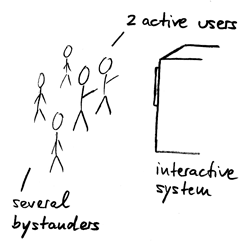| back to index | |||
H3 Cooperative Experience ** |
|||
 Two museum visitors using WorldBeat together. |
|||
|
...the overall structure of the interaction is in
place - Attract-Engage-Deliver, and
you are ready to think about the form in which each of those phases
should take place. You may already be considering a setup that
sketches the interaction of a single person with your system.
|
|||
|
* * *
|
|||
| Museums, exhibition centres and similar public places are
usually visited by groups of people. However, most interactive systems can
only be used by a single person at a time.
|
|||
|
Standard user interface design mostly cares about the scenario in which one person interacts with a computer. The term "Human--Computer Interaction" reflects this attitude, which for many interactive systems is quite acceptable. However, even when the social context of the user and his task are taken into account, it is not normally considered that the actual interaction can take place between two people sharing the same system. Those scenarios are rather dealt with in the discipline of computer-supported cooperative work. |
|||
| WorldBeat 2 batons |
The WorldBeat exhibit features not one, but two infrared batons to create musical input in many of its components. For example, the "Instant Salsa" setup, a part of the Joy-Sticks component, lets one user play a rhythmic Salsa pattern by swinging her baton up and down, while the second user can insert trumpet riffs and drum soli into the music by hitting downwards, or pressing the button on his baton. As the opening picture shows, users are having a lot of fun using the system in this way: instead of one user disappearing in a virtual world of interaction with a computer system, where only he knows what is happening, the system fades into the background and becomes a medium for two people to interact with each other, in this case musically. Its big advantage over normal human--human cooperation is that it can still augment the cooperation with subtle help, such as matching the notes created by both players onto a common musical scale. Of course, there are many situations where especially control input cannot reasonably be shared between people. WorldBeat, for example, only lets one of its two batons control the on-screen pointer used for menu selection and other control input, and only one baton is active in the conducting component (two people conducting at the same time would not make much sense). |
||
| Bystanders |
In addition to this active cooperative use, interactive exhibits should allow additional people to watch what is going on. This not only increases the number of visitors who can, at least in some way, experience the exhibit at the same time, it also helps them to prepare themselves if they are next in line to actively use it. This reduces subsequent learning time in the active usage phase, which also increases active visitor throughput. Moreover, it can attract passers-by who would never stop if all they saw is, say, a person staring into (and occluding) a small monitor. |
||
| The CAVE |
The CAVE installation in the Ars Electronica Center in Linz, Austria, offers a high level of this type of cooperative experience: not only the main user, but a dozen additional people, all wearing special digital glasses, can enter a room where walls and floor are large displays creating the illusion of a three-dimensional reality. While only the main user has a control for moving around this virtual environment, and only his position affords an ideal three-dimensional view, all other users in the room can participate in this experience to a high degree. Other exhibits in this centre, such as a flight simulator, feature large monitors mirroring what the active user currently sees, thereby communicating his experience to bystanders.
|
||
| Unplanned coorperation |
If cooperative experience is not planned, it will occur nevertheless. For example, where exhibits are equipped with headphones, people can often be observed sharing the single headphone set between them, awkwardly huddling together (and bending the headphone dangerously). What they are trying to do is to create a cooperative experience where the designer did not care to plan for one. |
||
|
Therefore: Allow two people to actively use your interactive exhibit together at the same time. Ensure that at least five bystanders can watch, listen to, or otherwise passively experience the exhibit while it is being used by somebody else. |
|||
 |
|||
|
* * *
|
|||
|
Cooperative use often involves one user handing control
over to the next - Easy Handover. Display size
has to be chosen correctly to create the right level of
immersion - Immersive Display ...
|
|||
This pattern is taken from the book "A Pattern Approach to Interaction Design" (PAID) by Jan Borchers (John Wiley and Sons, Chichester, UK, 2001). Copyright 2001 John Wiley and Sons. Used by permission. See http://media.informatik.rwth-aachen.de/paid.html for more information. Online version by Susan Babutzka, ETH Zurich (subabutz_at_student.ethz.ch). |
|||
